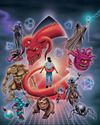Surveying post-Bloomberg New York with the technocrat futurist behind Sidewalk Labs.

DAN DOCTOROFF and I are standing on the 26th floor of the first tower to open in Hudson Yards, in the buzzy open-plan offices of a Google offshoot called Sidewalk Labs, for which he serves as CEO. Mostly young people, jacked up on free Joyride Coffee, are collaborating all around us, some putting Post-its on the floor-to-ceiling windows. Google’s parent company, Alphabet, calls its start-ups like Sidewalk “bets.” (Waymo, the self-driving-car company, is another one.) What Google is betting on is that its technologists can and should mediate our lives, for the good of all. In the case of Sidewalk, the goal is to make a better city, and the company is in search of a municipality to partner with on building a digitally optimized district from the ground up: an IRL beta-town. So far, Sidewalk has put those nine-foot-tall LinkNYC Wi-Fi kiosks on the sidewalks around New York. He also personally happens to be an investor in the company that runs Citi Bike, which I used to get over to the far West Side for the interview. (He lets me in on a secret: Sidewalk employees have their own private docking station.)
But we’re not here to talk about the city of the future; we’re discussing the city of today, the one built in the wake of 9/11. Doctoroff, then a partner in a private equity firm, was obsessed with the idea of bringing the Olympics to New York (the stadium was to be built where we’re standing now). He was recruited by Michael Bloomberg to be his deputy mayor for economic development and reconstruction. He was paid a dollar a year and resented by many career bureaucrats and political hacks for his lofty self-regard, something he admits he wasn’t always sensitive to. He’s written a book about those years—a combination manifesto- memoir—called Greater Than Ever: New York’s Big Comeback.
Diese Geschichte stammt aus der August 21–September 3, 2017-Ausgabe von New York magazine.
Starten Sie Ihre 7-tägige kostenlose Testversion von Magzter GOLD, um auf Tausende kuratierte Premium-Storys sowie über 8.000 Zeitschriften und Zeitungen zuzugreifen.
Bereits Abonnent ? Anmelden
Diese Geschichte stammt aus der August 21–September 3, 2017-Ausgabe von New York magazine.
Starten Sie Ihre 7-tägige kostenlose Testversion von Magzter GOLD, um auf Tausende kuratierte Premium-Storys sowie über 8.000 Zeitschriften und Zeitungen zuzugreifen.
Bereits Abonnent? Anmelden

LIFE AS A MILLENNIAL STAGE MOM
A journey into the CUTTHROAT and ADORABLE world of professional CHILD ACTORS.

THE NEXT DRUG EPIDEMIC IS BLUE RASPBERRY FLAVORED
When the Amor brothers started selling tanks of flavored nitrous oxide at their chain of head shops, they didn't realize their brand would become synonymous with the country's burgeoning addiction to gas.

Two Texans in Williamsburg
David Nuss and Sarah Martin-Nuss tried to decorate their house on their own— until they realized they needed help: Like, how do we not just go to Pottery Barn?”

ADRIEN BRODY FOUND THE PART
The Brutalist is the best, most personal work he's done since The Pianist.

Art, Basil
Manuela is a farm-to-table gallery for hungry collectors.

'Sometimes a Single Word Is Enough to Open a Door'
How George C. Wolfein collaboration with Audra McDonald-subtly, indelibly reimagined musical theater's most domineering stage mother.

Rolling the Dice on Bird Flu
Denial, resilience, déjà vu.

The Most Dangerous Game
Fifty years on, Dungeons & Dragons has only grown more popular. But it continues to be misunderstood.

88 MINUTES WITH...Andy Kim
The new senator from New Jersey has vowed to shake up the political Establishment, a difficult task in Trump's Washington.

Apex Stomps In
The $44.6 million mega-Stegosaurus goes on view (for a while) at the American Museum of Natural History.